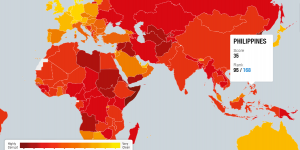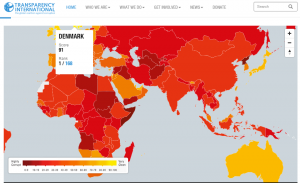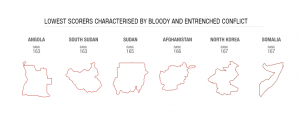
(Eagle News) — The Philippines had a score of 35 and a rank of 95 out of 168 countries, dropping 10 points from its previous rank of 85 in 2014, based on the latest Corruption Perception Index of Transparency International.
This means that corruptions remains a serious problem in the country. The higher the ranking meant that the country is perceived to be more corrupt. The 10-point difference in the rank of the Philippines meant more people perceived the country to be more corrupt than before.
Based on expert opinion, the Corruption Perceptions Index measures the perceived levels of public sector corruption worldwide.
The higher the score of a country, the cleaner its government is perceived to be. Denmark, for instance, which is perceived to be the cleanest government based on the Corruption Perception Index, has a score of 91, and a rank of 1 (least corrupt of 168 countries).
Overall, two-thirds of the 168 countries on the 2015 index scored below 50, on a scale from 0 (perceived to be highly corrupt) to 100 (perceived to be very clean).
In 2014, the Philippines had a score of 38. In 2013, its score was 36, and in 2012, its score was 34 indicating improving perceptions of corruption from 2012 to 2014. It was only in 2015 that its ranking dropped, indicating a serious corruption problem being perceived by more people regarding the Philippines.
Dark red indicates a highly corrupt public sector. Lighter red and orange countries fare a bit better, but corruption among public institutions and employees is still common. Yellow countries are perceived as cleaner, but not perfect.
The year 2015 showed that people working together can succeed in the battle against corruption. Although corruption is still rife globally, more countries improved their scores in the 2015 edition of Transparency International’s Corruption Perceptions Index than declined.

Courtesy Transparency International
The Philippines tied up with countries like Mexico, Mali and Armenia.
“The scale of the issue is huge. Sixty-eight per cent of countries worldwide have a serious corruption problem. Half of the G20 are among them,” said a press statement from Tranparency International.
“Not one single country, anywhere in the world, is corruption-free,” it said.
Denmark was the country characterized to have the least corruption and had the most transparent system with a rank of 1 and a score of 91.

Denmark took the top spot for the 2nd year running, with North Korea and Somalia the worst performers, scoring just 8 points each.
The countries which were perceived to have the least corruption aside from Denmark, were Finland (rank 2), Sweden (rank 3), New Zealand (rank 4), Netherlands (rank 5), Norway (rank 5), Switzerland (rank 7), Singapore (rank 8), Canada (rank 9) and Germany (rank 10).
“Corruption can be beaten if we work together. To stamp out the abuse of power, bribery and shed light on secret deals, citizens must together tell their governments they have had enough.Yet in places like Guatemala, Sri Lanka and Ghana, citizen activists in groups and on their own worked hard to drive out the corrupt, sending a strong message that should encourage others to take decisive action in 2016.
“The 2015 Corruption Perceptions Index clearly shows that corruption remains a blight around the world. But 2015 was also a year when people again took to the streets to protest corruption. People across the globe sent a strong signal to those in power: it is time to tackle grand corruption,” said José Ugaz, Chair of Transparency International.
Grand corruption is the abuse of high-level power that benefits the few at the expense of the many, and causes serious and widespread harm to individuals and society. It often goes unpunished.
This year Transparency International is calling on all people to take action by voting at unmaskthecorrupt.org. We want to know which cases the public most believe merit urgent attention to send a message that we will take a stand against grand corruption.
The index covers perceptions of public sector corruption in 168 countries.
Top performers share key characteristics: high levels of press freedom; access to budget information so the public knows where money comes from and how it is spent; high levels of integrity among people in power; and judiciaries that don’t differentiate between rich and poor, and that are truly independent from other parts of government.
In addition to conflict and war, poor governance, weak public institutions like police and the judiciary, and a lack of independence in the media characterise the lowest ranked countries.
The countries ranked as the most corrupt were Somalia, North Korea, Afghanistan, Sudan, South Sudan, Angola, Libya, Iraq and Venezuela, with Somalia ranking as the most corrupt.

The Corruption Perceptions Index is based on expert opinions of public sector corruption. Countries’ scores can be helped by open government where the public can hold leaders to account, while a poor score is a sign of prevalent bribery, lack of punishment for corruption and public institutions that don’t respond to citizens’ needs.







